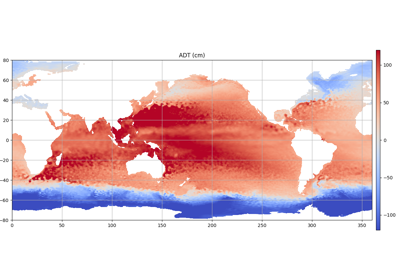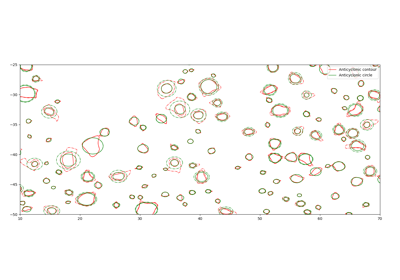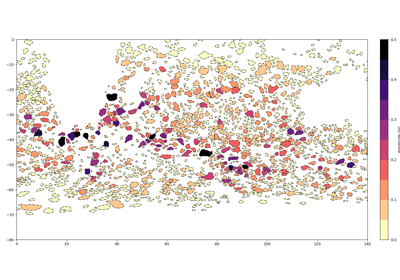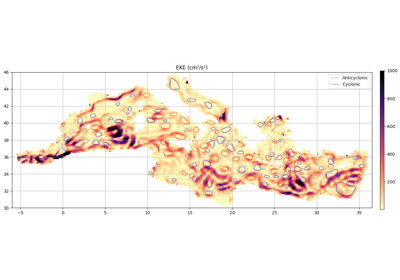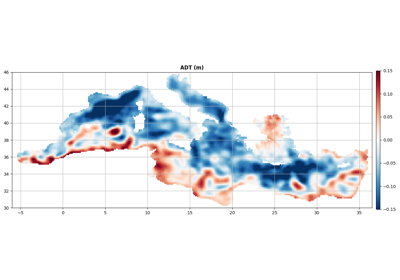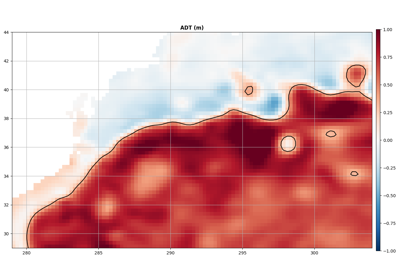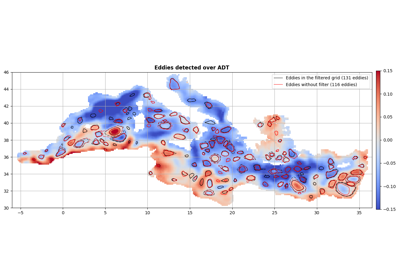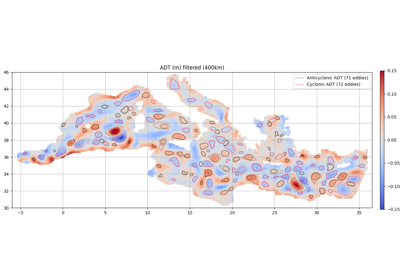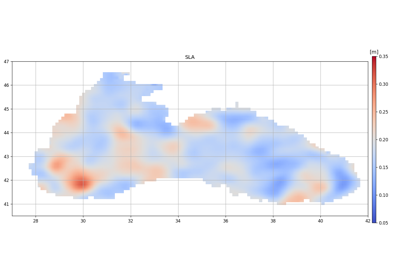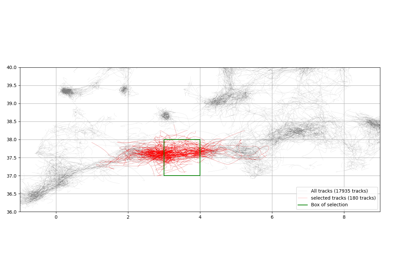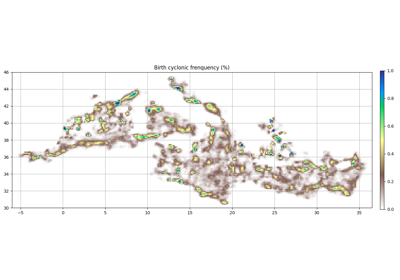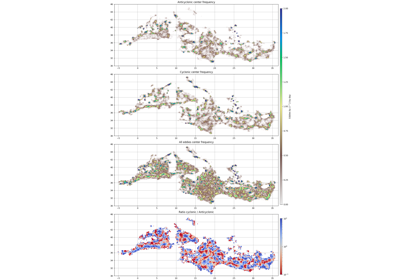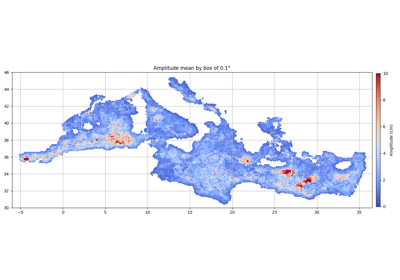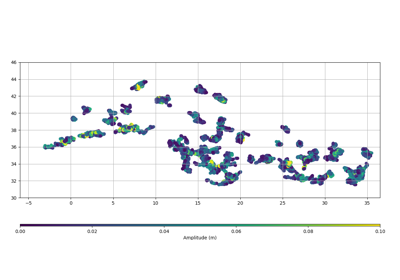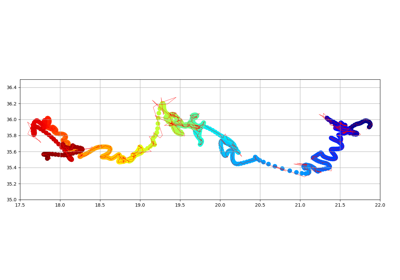py_eddy_tracker.observations.observation.EddiesObservations¶
-
class
py_eddy_tracker.observations.observation.EddiesObservations(size=0, track_extra_variables=None, track_array_variables=0, array_variables=None, only_variables=None, raw_data=False)[source]¶ Bases:
objectClass to store eddy observations.
Methods
Add a new field.
Align the time indexes of two datasets.
Merge.
Give major axis in km with a given latitude
- param str,array xname
variable to compute stats on
Return value evenly spaced with few numbers
Set contours as a circles from radius and center data.
Check coherence between two datasets.
Return index of contour which contain (x,y)
Copy with buffer for zarr.
Return the cost function between two obs.
How does it work on x bound ?
Plot the speed and effective (dashed) contour of the eddies
Use haversine distance for distance matrix between every self and other eddies.
Extract geographically with a bounding box.
Extract a subset of observations.
- param matplotlib.axes.Axes ax
matplotlib axe used to draw
Get first obs of each trajectory.
Get percentile of eddies in each bin
Count the eddies in each bin (use all pixels in each contour)
Return the mean of the eddies’ variable in each bin
Build histograms.
Return obs from self at the index.
Insert other obs in self at the index.
True for each point inside the effective contour of an eddy
Interpolate a grid on a center or contour with mean, min or max method
Get flag of the eddy’s convexity
Yield observation group for each bin.
Get Last obs of each trajectory.
Load the netcdf or the zarr file.
Load data from netcdf.
Load data from zarr.
Return index and score computed on the effective contour.
Merge two datasets.
Compute an intersection between all filters after to evaluate each of them
Filled virtual obs (C).
Scatter data.
Write something (TODO)
Track obs between self and other
Write a netcdf or zarr with eddy obs.
Attributes
Return dtype to build numpy array.
Return all the names of the variables.
Return period days cover by dataset
Return observations.
Give the time coverage
-
COLORS= ['sienna', 'red', 'darkorange', 'gold', 'palegreen', 'limegreen', 'forestgreen', 'mediumblue', 'dodgerblue', 'lightskyblue', 'violet', 'blueviolet', 'darkmagenta', 'darkgrey', 'dimgrey', 'steelblue']¶
-
ELEMENTS= ['lon', 'lat', 'radius_s', 'radius_e', 'amplitude', 'speed_average', 'time', 'shape_error_e', 'shape_error_s', 'speed_area', 'effective_area', 'nb_contour_selected', 'num_point_e', 'num_point_s', 'height_max_speed_contour', 'height_external_contour', 'height_inner_contour']¶
-
NB_COLORS= 16¶
-
array_variables¶
-
static
basic_formula_ellips_major_axis(lats, cmin=1.5, cmax=10.0, c0=1.5, lat1=13.5, lat2=5.0, degrees=False)[source]¶ Give major axis in km with a given latitude
-
bins_stat(xname, bins=None, yname=None, method=None, mask=None)[source]¶ - Parameters
- Returns
x array and y array
- Return type
array,array
-
contains(x, y, intern=False)[source]¶ Return index of contour which contain (x,y)
- Parameters
x (array) – longitude
y (array) – latitude
intern (bool) – If true use speed contour instead of effective contour
- Returns
indexs, -1 if no index
- Return type
array[int32]
-
static
copy_data_to_zarr(handler_zarr, handler_eddies, sl_obs, buffer_size, factor, raw_data, scale_factor, add_offset)[source]¶ Copy with buffer for zarr.
Zarr need to get real value, and size could be huge, so we use a buffer to manage memory :param zarr_dataset handler_zarr: :param array handler_eddies: :param slice zarr_dataset sl_obs: :param int zarr_dataset buffer_size: :param float zarr_dataset factor: :param bool zarr_dataset raw_data: :param None,float zarr_dataset scale_factor: :param None,float add_offset:
-
static
cost_function(records_in, records_out, distance)[source]¶ Return the cost function between two obs.
\[cost = \sqrt{({Amp_{_{in}} - Amp_{_{out}} \over Amp_{_{in}}}) ^2 + ({Rspeed_{_{in}} - Rspeed_{_{out}} \over Rspeed_{_{in}}}) ^2 + ({distance \over 125}) ^2 }\]- Parameters
records_in – starting observations
records_out – observations to associate
distance – computed between in and out
-
classmethod
cost_function_common_area(xy_in, xy_out, distance, intern=False)[source]¶ How does it work on x bound ?
- Parameters
xy_in –
xy_out –
distance –
intern (bool) –
-
create_variable(handler_nc, kwargs_variable, attr_variable, data, scale_factor=None, add_offset=None, **kwargs)[source]¶
-
create_variable_zarr(handler_zarr, kwargs_variable, attr_variable, data, scale_factor=None, add_offset=None, filters=None, compressor=None, chunck_size=2500000)[source]¶
-
display(ax, ref=None, extern_only=False, intern_only=False, **kwargs)[source]¶ Plot the speed and effective (dashed) contour of the eddies
- Parameters
ax (matplotlib.axes.Axes) – matplotlib axe used to draw
extern_only (bool) – if True, draw only the effective contour
intern_only (bool) – if True, draw only the speed contour
kwargs (dict) – look at
matplotlib.axes.Axes.plot()
-
distance(other)[source]¶ Use haversine distance for distance matrix between every self and other eddies.
-
property
dtype¶ Return dtype to build numpy array.
-
property
elements¶ Return all the names of the variables.
-
extract_with_area(area, **kwargs)[source]¶ Extract geographically with a bounding box.
- Parameters
area (dict) – 4 coordinates in a dictionary to specify bounding box (lower left corner and upper right corner)
kwargs (dict) – look at
extract_with_mask()
- Returns
Return all eddy tracks which are in bounds
- Return type
area = dict(llcrnrlon=x0, llcrnrlat=y0, urcrnrlon=x1, urcrnrlat=y1)
-
extract_with_mask(mask)[source]¶ Extract a subset of observations.
- Parameters
mask (array(bool)) – mask to select observations
- Returns
same object with selected observations
- Return type
self
-
filled(ax, varname=None, ref=None, intern=False, cmap='magma_r', lut=10, vmin=None, vmax=None, factor=1, **kwargs)[source]¶ - Parameters
- Returns
Collection drawed
- Return type
-
property
global_attr¶
-
grid_box_stat(bins, varname, method=50, data=None, filter=slice(None, None, None))[source]¶ Get percentile of eddies in each bin
- Parameters
- Returns
return grid of method
- Return type
-
grid_count(bins, intern=False, center=False, filter=slice(None, None, None))[source]¶ Count the eddies in each bin (use all pixels in each contour)
- Parameters
- Returns
return the grid of counts
- Return type
-
grid_stat(bins, varname, data=None)[source]¶ Return the mean of the eddies’ variable in each bin
- Parameters
bins ((numpy.array,numpy.array)) – bins (grid) to compute the mean on
varname (str) – name of variable to compute the mean on and output grid_name
data (array) – Array used to compute stat if defined
- Returns
return the gridde mean variable
- Return type
-
interp_grid(grid_object, varname, method='center', dtype=None, intern=None)[source]¶ Interpolate a grid on a center or contour with mean, min or max method
- Parameters
grid_object (py_eddy_tracker.dataset.grid.RegularGridDataset) – Handler of grid to interp
varname (str) – Name of variable to use
method (str) – ‘center’, ‘mean’, ‘max’, ‘min’, ‘nearest’
dtype (str) – if None we use var dtype
intern (bool) – Use extern or intern contour
-
iter_on(xname, bins=None)[source]¶ Yield observation group for each bin.
- Parameters
xname (str,array) –
bins (array) – bounds of each bin ,
- Returns
Group observations
- Return type
self.__class__
-
classmethod
load_file(filename, **kwargs)[source]¶ Load the netcdf or the zarr file.
Load only latitude and longitude on the first 300 obs :
kwargs_latlon_300 = dict( include_vars=[ "longitude", "latitude", ], indexs=dict(obs=slice(0, 300)), ) small_dataset = TrackEddiesObservations.load_file( filename, **kwargs_latlon_300 )
For **kwargs look at
load_from_zarr()orload_from_netcdf()
-
classmethod
load_from_netcdf(filename, raw_data=False, remove_vars=None, include_vars=None, indexs=None, **class_kwargs)[source]¶ Load data from netcdf.
- Parameters
filename (str,ExFileObject) – path or handler to load data
raw_data (bool) – If true load data without apply scale_factor and add_offset
remove_vars (None,list(str)) – List of variable name which will be not loaded
include_vars (None,list(str)) – If defined only this variable will be loaded
class_kwargs – argument to set up observations class
- Returns
Obsevations selected
- Return type
class
-
classmethod
load_from_zarr(filename, raw_data=False, remove_vars=None, include_vars=None, indexs=None, buffer_size=5000000, **class_kwargs)[source]¶ Load data from zarr.
- Parameters
filename (str,store) – path or store to load data
raw_data (bool) – If true load data without apply scale_factor and add_offset
remove_vars (None,list(str)) – List of variable name which will be not loaded
include_vars (None,list(str)) – If defined only this variable will be loaded
buffer_size (int) – Size of buffer used to load zarr data
class_kwargs – argument to set up observations class
- Returns
Obsevations selected
- Return type
class
-
match(other, method='overlap', intern=False, cmin=0, **kwargs)[source]¶ Return index and score computed on the effective contour.
- Parameters
other (EddiesObservations) – Observations to compare
method (str) –
“overlap”: the score is computed with contours;
”circle”: circles are computed and used for score (TODO)
intern (bool) – if True, speed contour is used (default = effective contour)
cmin (float) – 0 < cmin < 1, return only couples with score >= cmin
kwargs (dict) – look at
vertice_overlap()
- Returns
return the indexes of the eddies in self coupled with eddies in other and their associated score
- Return type
-
merge_filters(*filters)[source]¶ Compute an intersection between all filters after to evaluate each of them
-
property
obs¶ Return observations.
-
observations¶
-
only_variables¶
-
period_¶
-
propagate(previous_obs, current_obs, obs_to_extend, dead_track, nb_next, model)[source]¶ Filled virtual obs (C).
- Parameters
previous_obs – previous obs from current (A)
current_obs – previous obs from virtual (B)
obs_to_extend –
dead_track –
nb_next –
model –
- Returns
New position C = B + AB
-
raw_data¶
-
scatter(ax, name=None, ref=None, factor=1, **kwargs)[source]¶ Scatter data.
- Parameters
ax (matplotlib.axes.Axes) – matplotlib axe used to draw
name (str,array,None) – variable used to fill the contour, if None all elements have the same color
factor (float) – multiply value by
kwargs (dict) – look at
matplotlib.axes.Axes.scatter()
- Returns
scatter mappable
-
property
shape¶
-
property
sign_legend¶
-
sign_type¶
-
track_array_variables¶
-
track_extra_variables¶
-
property
tracks¶
